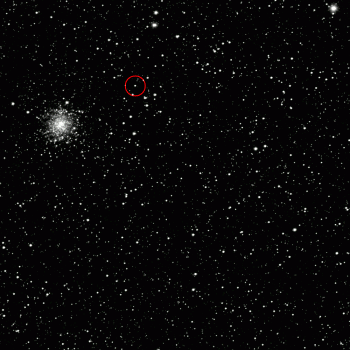Tomorrow, Rosetta will conduct a massive orbit correction manoeuvre (OCM) deep in our Solar System, switching on its thrusters for a bit less than 8 hours to reduce its speed relative to comet 67P by a whopping 291 metres/second (m/s) – one of the longest burns in ESA spaceflight history.

A sequence of images showing comet 67P/Churyumov–Gerasimenko between 27 March and 4 May 2014 (CLICK TO SEE ANIMATION). Credit: ESA/Rosetta/MPS for OSIRIS Team MPS/UPD/LAM/IAA/SSO/INTA/UPM/DASP/IDA
The burn starts at 15:23 UTC (17:23 CEST) on board and will be carried out autonomously; the commands were already uploaded on Tuesday.
The burn will take place during ground station visibility, via ESA’s 35m ground station at New Norcia, Australia, meaning that the Rosetta mission control team at ESOC will be able to receive telemetry (on-board status data) and monitor progress as it happens.
The massive burn marks the first of a trio of ‘big burns’ planned for 21 May, 4 June and 18 June; these are designed to reduce the relative speed with respect to the comet by 290.89, 270.98 and 90.76 m/s, respectively. (The engineers refer to these numbers as the ‘change in velocity’, or ‘delta-v’.)
On 7 May, Rosetta kicked off the current series of 8 OCM manoeuvres (through to end July) with a test burn, targeting a delta-v of just 20 m/s.
“We were especially keen to see how well the propulsion system functioned,” said Sylvain Lodiot, Spacecraft Operations Manager. “The burn went well and we’re on track now for the big ones coming up.”
(See Thruster burn kicks off crucial series of manoeuvres for details on why the orbit correction manoeuvres in May, June and July are so crucial to successfully arriving at the comet on 6 August.)
The manoeuvres aim, between now and the end of July, to reduce the distance between the two and lower the spacecraft’s speed relative to the comet.
“The manoeuvres, carried out with 10N thrusters, will bring the spacecraft a step closer to the comet, so that, upon arrival, early August, we should be at 100km distance and 1 m/s relative velocity,” says Sylvain.
On 21 May, before the burn, Rosetta will be 1 005 056 km from the comet, and will be moving with a relative speed (Vrel) of 754.1 m/s. The one-way radio signal time will be 27 min:50 sec.
We’ll provide an update on burn results later on Thursday.
Follow @esaoperations via Twitter for updates.









Discussion: 9 comments
How do the thrusters work? What do they push against, if space is so empty…..?
Hi John: Have a look here, and then post back if you still have any questions. Cheers!
https://scienceblogs.com/startswithabang/2010/03/15/thrusters-in-space/
Thanks Daniel, got it. No wonder the thruster has to burn for so long. This is a really amazing story btw, I’m glued to all the updates.
Are you performing the maneuvers in blow-down mode or did/will you re-pressurize the tanks? What’s the difference between the two modes in terms of fuel consumption, and how much delta-v will be left after the maneuvers assuming everything goes nominal, and what are your margins? Thank you.
Hi Nils: The manoeuvres will be conducted in blow-down mode. For the rest of the answer, we have to check with the Rosetta mission team at ESOC, who are rather busy today with the second OCM. We’ll get back to you as soon as possible. Cheers!
“10N” thrusters ? Did you mean “ion” … which makes more sense !
No, that is indeed 10 N, as in ten Newtons, a measure of the force of the individual thrusters.
The Newton is the SI unit for force and since force = mass x acceleration, 1 Newton is defined as being 1 kg times 1 metre per second-squared.
To give a sense of what that means in real terms, the acceleration due to Earth’s gravity is roughly 10 metres per second-squared. Thus a 1 kilo bag of sugar is being held down by the Earth’s gravity by a force of about 10 Newtons, i.e. the force exerted by each of Rosetta’s thrusters.
Rosetta has 24 of these thrusters (which use bipropellant, not ions), but just 4 are used for these manoeuvres. A little bit of maths will show you that pushing around a spacecraft that weighs roughly 3 tonnes with just 4 such thrusters takes a bit of patience …
There’s a lot more nice information on the thrusters and how they’re used in an earlier blog post:
https://blogs.esa.int/rosetta/2014/05/07/thruster-burn-kicks-off-crucial-series-of-manoeuvres/
Hope that helps clear up the confusion 🙂
Thanks for that – it was the lack of space between “10” and “N” which made it look like a typo rather than a force value !
It’s probably short for “10 Newton” thrusters. Newton is a unit of force (N=mass*acceleration). A force of 10N is approximately equivalent of you lifting something which weighs 1 kilogram here on Earth.